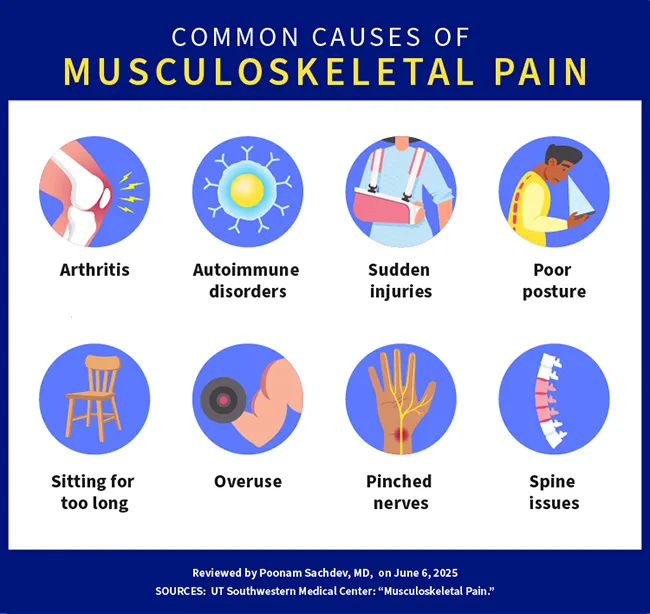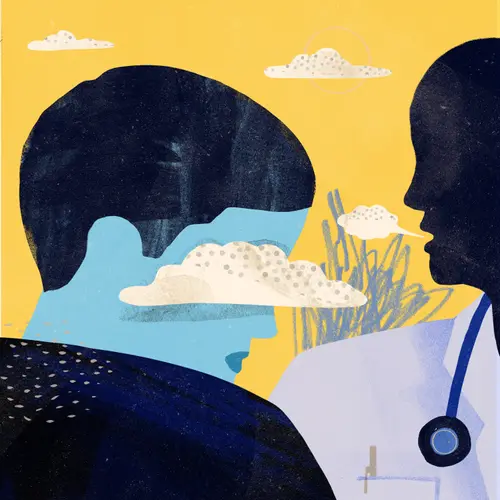Musculoskeletal pain refers to pain that starts in your muscles, bones, joints, tendons, or ligaments. It's very common and can happen at any age. Almost everyone has it at some point in their lives. If you've ever strained your back, twisted your ankle, broken a bone, or ached because of arthritis, you've had musculoskeletal pain.
While mild cases can often be treated at home, pain that starts suddenly should be checked out by a doctor.
What Causes Musculoskeletal Pain?
Your musculoskeletal system supports your body and helps you move. It’s a complex network of muscles, bones, and tissues that connect them. These include:
Ligaments.Tough bands of tissue that help keep your joints stable and connect one bone to another.
Tendons. Strong, flexible tissues that attach your muscles to your bones so you can move.
Fascia. A thin, slippery layer of tissue that wraps around every bone, muscle, tendon, and ligament. It gives your body support and strength.
There are two general reasons why part of your musculoskeletal system might start to hurt:
Sudden pain. This kind of musculoskeletal pain comes on quickly and can feel sharp or severe. It often happens after an accident or injury.
Chronic pain. This type of pain can last a long time. It’s often linked to arthritis or fibromyalgia (a long-term condition that causes pain all over your body). But it can also come from an injury that didn’t heal properly or was never treated.
Here’s a closer look at what can cause different types of musculoskeletal pain in your body.
Bone pain
While injuries are the most common culprit, your bones can also ache because of:
- Hormone disorders
- Bone infection
- Tumors
Muscle pain
Your muscle tissue can get damaged from the wear and tear of daily activities. It can also happen because of:
- Loss of blood flow
- Infection
- Tumor
- Inflammatory conditions (such as polymyalgia rheumatica)
Ligament and tendon pain
You’re most likely to feel this kind of pain after a sprain or another type of injury. Other reasons include:
- Tendinitis (an inflamed tendon)
- Tenosynovitis (when both a tendon and the protective layer around it get inflamed)
Bursae pain
You have tiny, fluid-filled sacs called bursae, which protect your joints and help them move smoothly. They can hurt because of:
- Overuse
- Injury
- Infection
- Gout
Joint pain
Many conditions can make your joints ache. Among them are:
- Osteoarthritis
- Rheumatoid arthritis
- Severe bone injury
- Gout
- Autoimmune conditions
- Vasculitis (conditions that inflame your blood vessels)
- Fibromyalgia
- Pinched nerves (like in carpal tunnel syndrome)
Sometimes, musculoskeletal pain happens because of another health problem in your body. You might feel arm pain during a heart attack. Back pain could point to other conditions, such as a kidney stone or an inflamed pancreas.

What Are the Symptoms of Musculoskeletal Pain?
Your symptoms depend on where the pain is and what's causing it. More than 150 conditions can affect your musculoskeletal system. The most common sign is trouble moving the way you normally do. You might also have:
- Trouble sleeping
- Fatigue
- A "pins-and-needles" feeling
- A burning sensation
- Stiffness
- Muscle twitches
The type of pain you have can also vary. For instance:
- Bone pain usually feels deep and intense.
- Muscle pain often includes cramps or spasms.
- Tendon and ligament pain typically gets worse when you move or try to stretch.
- Joint pain is often described as achy or sore. It may come and go.
How Is Musculoskeletal Pain Diagnosed?
Your doctor will start by asking you about your symptoms and health history. Then, they'll do a physical exam.
They could also order one or more of the following tests:
- X-ray or CT scan, to look at your bones
- MRI or ultrasound, to check soft tissue such as your tendons
- Nerve conduction test, to see if any of your nerves are pinched
- Blood test, for signs of conditions like rheumatoid arthritis
- Bone scan, which can show different types of bone disorders
- Joint fluid testing, to look for signs of infection
- Myelogram, an imaging test that provides a detailed look at your spine
How Is Musculoskeletal Pain Treated?
Your treatment depends on what's causing your pain and which parts of your body are involved.
For mild musculoskeletal pain, your doctor might recommend home care. One common option is something called the RICE method. That stands for:
Rest. Give your body a break so it can heal.
Ice. Apply cold packs for no more than 10 minutes at a time.
Compression. Wrap the painful area with a stretchy bandage to help reduce swelling.
Elevation. Raise the area, especially if it's swollen.
Some doctors still recommend RICE to manage swelling early on, but inflammation also plays an important role in healing. If you reduce it too much or stop it too soon, it might actually slow down your recovery.
"The body can sometimes heal these issues, although it's slow, and that's why they last for a while," says Clint Soppe, MD, a board-certified orthopedic surgeon and sports medicine specialist at Cedars-Sinai Orthopaedics in Los Angeles.
Some experts suggest small changes to the RICE method. Instead of complete rest, they encourage gentle movement. This updated approach is sometimes called MICE (Motion, Ice, Compression, Elevation) or RACE (Recover Actively, Compress, Elevate).
For more serious issues, your treatment could include:
- An over-the-counter pain relief medication
- Brace, splint, or cast to support and protect the painful area
- Physical therapy, to learn exercises that will help you safely regain your strength
- Occupational therapy, so you can get tips to manage pain in your daily life
- Acupuncture
- Cognitive behavioral therapy, to learn new ways to cope with ongoing pain
- Chiropractic adjustment
- Massage therapy
- Prescribed medications, such as steroid injections, muscle relaxants, or nerve root blocks
Ignoring musculoskeletal pain can lead to bigger problems later. "Fractures, if left unmanaged, can sometimes heal in a way that can cause chronic pain or disability, and can be much more difficult to fix later," says Soppe.
If you feel pain after a fall, injury, or accident, see a doctor. Some injuries won't heal right without surgery.
When musculoskeletal pain comes from a condition like fibromyalgia that affects your whole body, your doctor may also prescribe medications to lower inflammation, improve sleep, or ease fatigue.
What Is Amplified Musculoskeletal Pain Syndrome (AMPS)?
AMPS is a long-term (chronic) condition that makes you feel more pain than usual, even when there's no clear cause. Your brain and nerves make pain signals stronger, so things such as a bump, movement, or even touch can hurt more than they should.
You may feel pain in your muscles, joints, or bones, and it can move around or affect more than one area. AMPS usually starts in kids and teens, but it can also affect adults and is often diagnosed as fibromyalgia. Stress, illness, or an injury can sometimes trigger it.
Along with pain, you might notice other symptoms, such as:
- Belly pain or nausea
- Anxiety
- Trouble eating or swallowing
- Feeling dizzy
- Feeling tired all the time
- Headaches
- Skin that hurts to touch
- Joint pain
- Trouble moving (feeling stiff, shaky, or uncoordinated)
- Swelling in certain areas
- A fast heartbeat
- Skin that feels rough, warm, cold, or looks a different color
- Tingling or numbness in your body
AMPS shows up in different ways, depending on where you feel the pain and how it acts. The main types include:
- Complex regional pain syndrome (CRPS): Usually causes pain in your arm, leg, hands, or feet
- Diffuse amplified pain: Affects your whole body, sometimes called juvenile fibromyalgia
- Intermittent amplified pain: Comes and goes
- Localized amplified pain: Stays in one specific spot
Pain medication can help with your symptoms, but it won't cure AMPS. Other ways to manage it include:
- Aerobic exercise
- Massage therapy
- Occupational therapy
- Physical therapy
- Counseling
- Procedures or injections
You can also try wellness and relaxation tools such as yoga, music therapy, mindfulness, and healthy diet changes.
Takeaways
Musculoskeletal pain can affect your muscles, bones, joints, and the different tissues that connect them. It's very common and can happen for many reasons. In mild cases, the pain is short-lived and goes away once the area heals. Other cases can be more complex and need a doctor's help to improve. Don't feel that you have to power through your pain. Your doctor has many options to help you feel more comfortable.
Musculoskeletal Pain FAQs
What is the best pain relief for musculoskeletal pain?
The best pain relief for musculoskeletal pain depends on your symptoms and overall health. Ibuprofen can ease swelling and may work well for sprains or sore muscles. Acetaminophen may help more with arthritis or joint pain. Talk to your doctor to find the right option for you.
What are four types of musculoskeletal injuries?
Four common types of musculoskeletal injuries include sprains, strains, bone fractures, and dislocated joints. Strains can happen from overuse, such as tennis elbow or carpal tunnel syndrome. A dislocated joint means a bone has popped out of place, like in your shoulder or knee.
What are the signs of musculoskeletal chest pain?
Musculoskeletal chest pain happens when the muscles, bones, or tissues near your heart hurt. You might feel pressure, squeezing, tingling, or numbness. The pain usually stays in one spot, feels steady, and gets worse when you move, press on the area, cough, or sneeze. Always see a doctor right away if you have chest pain.
How long does musculoskeletal chest pain last?
The duration of musculoskeletal chest pain depends on what's causing it. Some types get better with rest, pain relievers, and hot or cold packs. Others may last longer and need ongoing care. You should always see a doctor to find out the cause of your chest pain, especially if it's new. They'll check to make sure it's not heart-related before calling it musculoskeletal.


